Figures & Formulas: The Maths Behind Slot Games
Have you ever wondered about how casino slot payouts work? Well, wonder no more! LadyLucks Casino have run the numbers and we can now explain how casinos generate their slot machine payouts.

We look at the difference between old mechanical slots and modern video slots, as well as going into detail about return to player rate (RTP) and slot volatility.
We’ll also discuss how all these factors can ultimately affect your slots payouts. So buckle up and get ready for some maths! It’s not too difficult though – we promise.
Mechanical slots payouts
Mathematics and gambling have always been linked. Shrewd players hunt for ways to gain tiny advantages by utilising the facts and figures surrounding slot machine payouts, while casinos are searching for fresh mathematical tools that could help attract new players.
Slot machines were originally mechanical inventions. Let’s think of a classic three-reel fruit machine as our example, with only one payline. You win the top payout by landing three ‘lucky 7s’ in a row, where each reel has seven symbols in total.
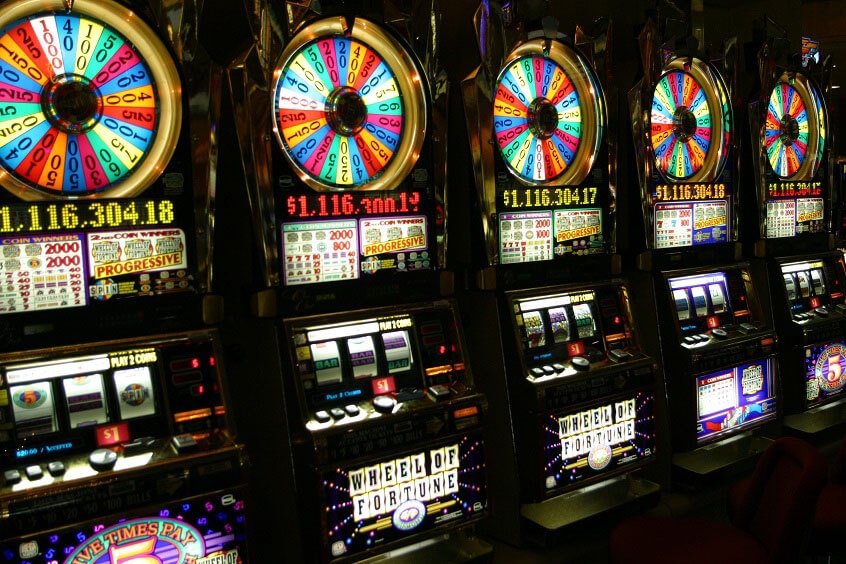
The chance of hitting the jackpot is 1 in (7x7x7), aka 1 in 343 or about 0.29%. In order to make money, the casino has to offer a jackpot lower than that – say £300 for betting £1. But if you’re used to modern day video slots, you’ll know that’s a pretty paltry top prize.
If casinos want to offer a bigger payout, they have to ensure the chances of landing the jackpot are as small as possible. One way to increase the jackpot on offer is to up the number of symbols on the reels.
Changing from seven symbols to 12 per reel, decreases the slot machine payout odds to 1 in (12x12x12), which comes out to 1 in 1,728 or 0.06%. This allows the casino to set the jackpot at £1,700 – but it’s still not a huge amount of money, and has a very low chance of occurring.
Adapting the machine to a five-reel game adds a further two steps of multiplication to the calculation. Keeping the original seven-symbol reel, the chance of filling the payline with ‘lucky 7s’ suddenly jumps from 1 in 343 to 1 in 16,807 – so, in this case, the jackpot could reasonably increase to £16,000.
But if you think about the jackpots on offer from games today, they couldn’t utilise either of these methods. Imagine how many reels or symbols you’d need on a mechanical slot machine if you wanted to offer a jackpot worth hundreds of thousands!
The origin of random slots
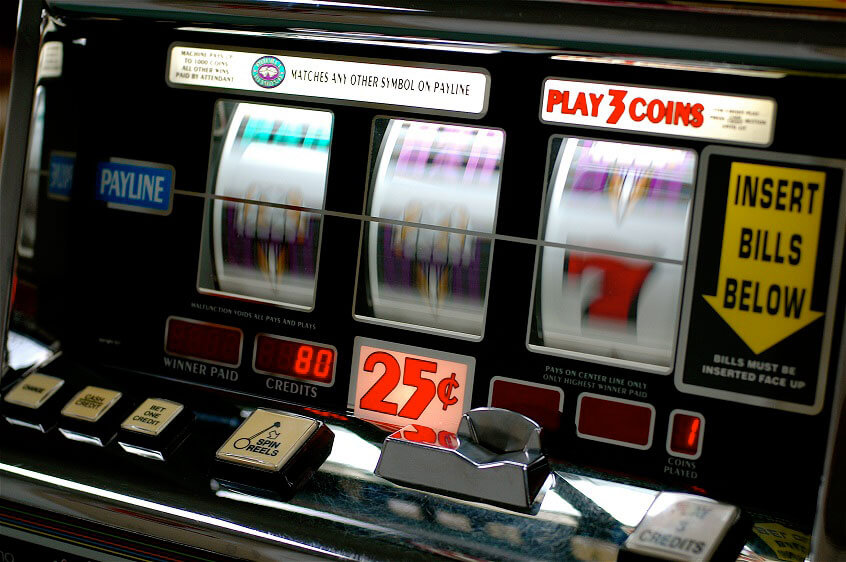
Another problem with mechanical slot machines was the impossibility of randomising them properly. Some casinos hooked them up to a timer which determined when they would pay out, but gamblers soon learned to exploit this.
An example of this was professional blackjack and poker player Cat Hulbert: at one point, she employed teams of elderly contractors to play slots for her when they neared a payout time.
Slot machines were transformed in 1984 thanks to Norwegian mathematician Inge Telnaes. His big idea was that, instead of spinning actual reels, a random number generator should dictate the results. You could create a visual representation of the slots and show either a winning combination or a random collection of losing symbols.
The random number generator could be programmed to offer odds that reels themselves can’t, and so you can offer much longer odds on winning combinations. IGT purchased Telnaes’ patent back in 1989, and thus earned royalties as other companies started using the random number model too.
Whilst creating truly random numbers can be impossible, the pseudo-randomness that most random number generators offer is usually good enough. The strings of numbers which are generated can usually create long runs with many random properties.
You can also manipulate the randomness of the numbers, though this must be accurately reflected by the return to player (RTP) listed on the machine.
How return to player rate works
Every slot you play online will have a RTP listed with it. This is typically somewhere between 92% and 98% and represents, in simulations, how much players will expect to receive back after an extended run of play.
In this case, the player would be set to walk away with £98 in their pocket. However, that’s far from the truth.
Slot machines are very rigorously tested and spun thousands upon thousands of times to ensure their advertised RTP is correct. If you ever feel like you’re not seeing the RTP advertised on them, it’s due to sheer randomness – and the weighting of jackpots, as you’ll see when we break down a slot in the next section.
A similar example to help wrap your head around this is flipping coins: you know that it’s a 50% chance to land heads or tails, but that’s over one flip. In 100 coin flips, you only actually have an 8% chance of having 50 heads and 50 tails.
Using binomial expansion, you can work out what the chance of this happening is – so, if you repeated the 100 flips 100 times, how many of those sets would actually have the perfect 50-50 split? The answer is 8%.
But if you look at how many sets come out as close to 50% – say with between 40 to 60 heads – then the probability of this is much higher. The maths behind this is fairly complicated, but you can use a binomial calculator to prove it: the chance of success is 0.5, there are 100 trials, and 50 successes. You actually end up with a 7.96% of succeeding.
Use this as a reference for how unlikely perfect averages are: if you only get a perfect 50/50 split when flipping a coin 8% of the time, then think about how many different variations there are in a slot machine full of different symbols and stops. You would need a massive amount of time to see the average number overpower the inherent unpredictability of the random number generator.
Slot payouts’ percentage are worked out over a huge amount of time and a long string of spins. You need lots of spins to work out the average without being affected by the slot volatility.
The longer you play a slot for, the nearer you will get to that elusive RTP figure – but your bankroll would have to be enormous to actually see it work out!
It’d be much more reasonable to think of RTPs as expectations for millionaires: if you paid £1 million into a slot machine, you could expect to see £980,000 back from it.
Obviously, no one person puts that in as one lump, but the machine might get that paid into it, in total, over the course of its lifetime. So the machine keeps £20,000 of the money that’s put in, assuming everything perfectly adheres to mathematical models.
Understanding slot payout : breaking down a simple slot
So now we know a bit about slots, let’s look at the maths behind the payouts. This is a very simple example, and it uses our three-reel, seven-symbol, one-payline slot that we outlined in the first section.
For ease of argument, there are no special features here, no wild symbols, and no scatters. All of the paying combinations have to be found left-to-right in order to trigger the slot payout.
The Slot payouts are going to be as follows:
- 3 Lucky 7s = £100
- 3 of any other symbol = £10
- 2 Lucky 7s = £10
- 2 of any other symbol = £3
There’s only one combination you can get to win the top prize, but we’ve introduced further methods of winning too. Three of any other symbol has six combinations, as does the chance of spinning two Lucky 7s. But two of any other symbol is much more common, as there’s 36 ways that might show up in the slot machine.
Out of 343 combinations, only 49 in total (1+6+6+36) yield a reward, which only provides a 14.3% chance of pulling up a winning spin. However, that improbability is balanced out by higher wins.
If you multiply the number of combinations that can win by the number of coins you’d win, you come up with your potential pay-off per coin:
- 3 Lucky 7s = 1 x £100 = 100
- 3 of any other symbol = 6 x £10 = 60
- 2 Lucky 7s = 6 x £10 = 60
- 2 of any other symbol = 36 x £3 = 108
And adding these figures together gives us the total number of coins we could win from this spin
100 + 60 + 60 + 108 = 328
Divide this by the total number of spins – 343 – and times the result by 100, and we get the slot payout percentage:
(328 / 343) x 100 = 95.6%
With this slot, someone could come along and assume that putting £100 into this slot would give them a return of £95.60. However, looking at the maths behind it, we know that this isn’t necessarily true.
It would be more accurate to think that a millionaire putting £1 million into it could walk away with £956,000 – and that the slot machine keeps the remaining £44,000 that it won through house edge.
What about slot volatility?
Slot volatility has a huge effect on how people play games. You can target different groups by changing a slot’s volatility up or down, though this might be represented by the same RTP.
A low volatility slot will reliably pay out small amounts over and over, and is ideal for players who want to keep spending their bankroll without too much chance of losing it all.
However, high volatility slots are the ones with huge jackpots: they’re designed to draw you in for a quick shot at winning big money with the understanding it’s very unlikely.
In our Lucky 7s slots, we can safely say that it has high volatility. Only 14.3% of spins will yield a winning combination; so, if you spin the slot 1,000 times, you’ll only be mathematically expected to trigger 143 wins.
However, the draw of the jackpot – £100 for a single perfect combination – mitigates this. There’s still a high return on investment because of the significant boost that rolling a top prize gives.
Slots with many paylines and different distributions of symbols are much more complicated to calculate, but the principle remains the same.
If big wins make up the bulk of the reward, it’s high volatility; if your slot payouts come from small and frequent wins, then it’s low volatility. And both high and low-volatility slots can vary in their advertised RTP.
Scaling returns
The final, minor point to make about slot machine maths is that some machines have scaling returns. If you ever see RTP shown as a range rather than as a single figure, it implies the slot you are playing on has different payout chances – and this usually depends on the amount of money you stake.
Consider a progressive slot game, where much of the RTP is made up of the small chance of landing a huge jackpot, there may be a higher chance of triggering the top prize if you stake more. This also means that you’re putting up more money to lose, but it does technically change the casino’s edge.
Even if you only tilt the slot payout percentage a little bit – by 1% or 2% – the increased earnings on the slot can offset the larger wins, especially as many people may exhaust their bankroll into the machine without winning big money.
Scaling returns are a more common phenomenon in land-based casinos. Online casinos tend to be more consistent across all denominations, to ensure they don’t unfairly privilege high rollers.
Our Top 3 best slot machine payouts
Now you understand the maths behind slots, why not put your theoretical knowledge to the test?
Book of Dead
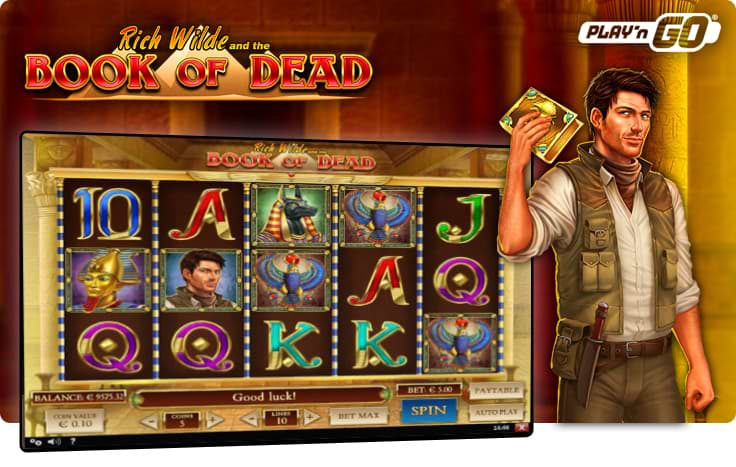
Since its launch in 2016, Play’n GO’s Book of Dead has become a must-play slot that you’ve probably seen appear in many top rankings as it is quite simply one of the best slots ever created!
With this game, Play’n GO has managed to capture the style of bonus features that thrill us.
The Wild symbol is also the trigger symbol for bonus games (Scatter) and is represented by the Guestbook. Knowing that each book can replace any other symbol in the game, this can only increase the winnings.
And you’re not done winning yet, because a random bonus feature will also pop up. This time during the Book of Dead free spins game.
Finally, to finish convincing you, Book of Dead has a fixed jackpot of £250,000!
Quest to the West

With a RTP of 97.53%, Quest To The West slot is a very recent game that is well above average! The game is still a highly volatile online video slot game that offers superb payouts alternating with periods that won’t pay too much.
This slot machine favours small players or those who like to be in control and not risk too much on their bets, which is important in order to play responsibly.
Although it may seem overly simple compared to other slots that have multiple features and special symbols, Quest To The West has real potential for winning.
Megaways™ slots

The Megaways™ slot machines are innovative, fun and feature extremely smooth animations and highly detailed graphics.
But above all what attracts players is the Megaways™ system, created by Big Time Gaming and later used by other developers, which offers players the possibility to play on slot machines with multiple pay lines, up to 117,649 ways to win, such as the Extra Chilli slot.
Big Time Gaming has gone one step further, offering 586,971 ways to win on the superb Holy Diver slot, which also includes the revolutionary Reel Adventure game mechanism.
And to top it all off, Big Time Gaming’s slots can offer you an average of up to 20,000x your bet!
If you want to get the best slot payouts in the UK on online casinos, check out some of the great games available at LadyLucks Casino. We’ve got a great range of slot reviews you can enjoy, with a variety of paylines, slot volatility or RTP to suit every kind of player.
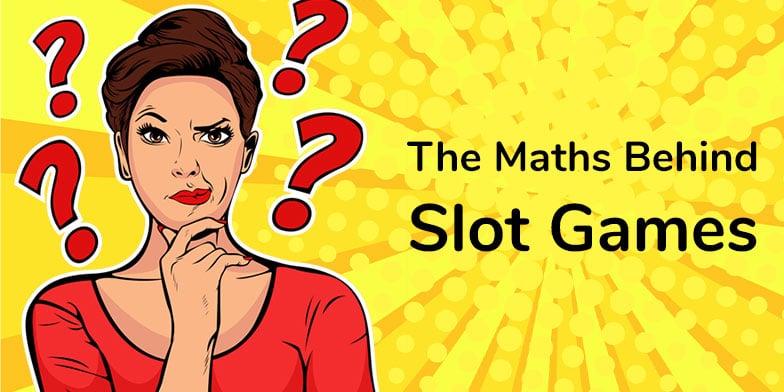
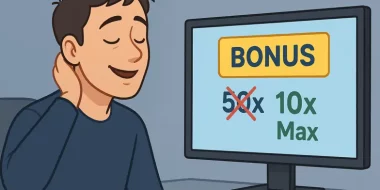




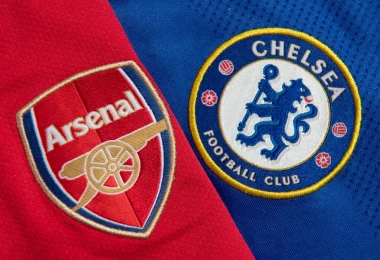
Leave a Reply